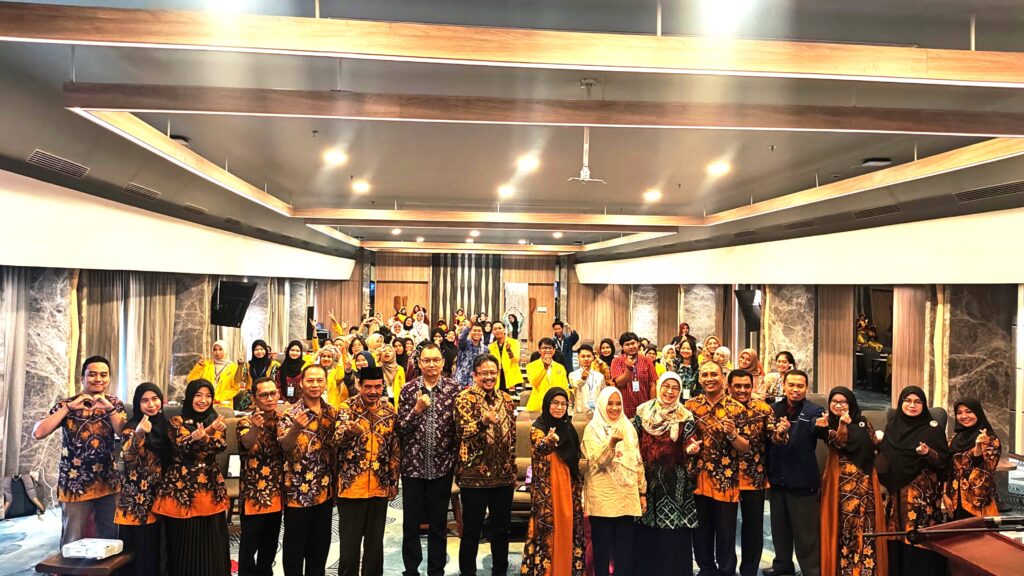18/05/2024

Banjarmasin – After holding a public lecture on the curriculum the day before, the Physics Education Study Program of the Faculty of Teacher Training and Education (FKIP) of Universitas Lambung Mangkurat (ULM) on Saturday, May 18, 2024, held the National Seminar on Physics Education (SNPF) at Harper Hotel from 08.00 to 16.30 WITA. The annual agenda of the Physics Education Study Program took the theme Synergy of Innovation and Evaluation of Physics Learning in the Independent Curriculum and presented 3 speakers, namely Professor of Surabaya State University (Unesa), Wahono Widodo; lecturer and education policy researcher from the International Islamic University of Indonesia, bambang Sumintono; and lecturer of Physics Education Study Program FKIP ULM, Mustika Wati. The event was divided into 2 sessions, namely seminar sessions and paper presentation sessions. This activity was opened by the Deputy Dean for Academic Affairs, Deasy Arisanty, and attended by lecturers of Physics Education FETT ULM and invited guests including the Head of the Department of Mathematics and Natural Sciences Education (JPMIPA) FETT ULM, Syahmani and the head of the Physical Society of Indonesia, Ninis Hadi Haryanti.
The head of the committee, Dewi Dewantara, said that SNPF is a routine activity that is carried out every year in collaboration with Himapsika (Student Association of Physics Education), and collaborates with the Physical Society of Indonesia. This activity is a forum to add insight into the development of physics learning. “This year the theme focuses on innovation and physics learning in the independent curriculum. This seminar is also a publication forum for participants, because presenters can present orally the results of their research, and can be published in proceedings with ISSN and journals that have been accredited by Sinta, namely the Physics Education Scientific Periodical, Physics Education Scientific Journal, JMSECEdu, and other journals,” she explained.
Dewi also mentioned that participants and presenters (122 papers) came from various universities and institutions including Jakarta State University, Jambi University, Sebelas Maret University, Lambung Mangkurat University, Bengkulu University, State Islamic University (UIN) Alauddin Makassar, Makassar State University, UIN Syarif Hidayatullah, Riau University, University of Education Indonesia, State University of Malang, UIN Sunan Gunung Djati Bandung, UIN Sunan Kalijaga, UIN Antasari, BRIN (National Research and Innovation Agency), as well as teachers from SMA / SMK and MA such as SMAN 6 Banjarmasin, SMKN 4 Banjarbaru, SMAN 1 Mantewe, and others.
According to the head of the Physics Education Study Program, Abdul Salam, the invited speakers are competent professors and education experts to lead participants to discussions related to learning innovations that can be used as alternative choices for teachers when implementing learning along with assessments that are in line with the demands of the Merdeka Curriculum. In line with that, one of the speakers, Bambang Sumintono, in a presentation related to assessment innovation, explained about Rasch Modeling analysis on science education cognitive tests. According to him, this analysis includes (1) assessment of the level of difficulty and accuracy of the questions (how much and how precise), (2) question accuracy/content validity/misconception(how good)[multi-level multiple choice], (3)eliminators/item distractors,(4) item bias (different item functioning), (5) normative reference assessment/leveldescriptor with logit person or logit item data, (6) profiling test takers(how good, scalogram, diagnostic), (7) analysis of experimental design: racking and stacking, and (8) instrument level analysis: reliability, validity (unidimensional, rating/rubric scale, wright map), item bank.
Meanwhile, Mustika Wati delivered more contextual material in the use of the Rasch model, namely the assessment of high school physics science literacy based on local wisdom and the Pancasila Student Profile. In her presentation, Mustka explained the assessment for high school students on particle dynamics material using the Rasch Model. According to him, assessment indicators in science literature include explaining scientific phenomena, interpreting scientific data and evidence, and evaluating and designing scientific investigations. In contrast to the classical theoretical approach, Rasch modeling uses individual ability level analysis as a tool to differentiate the ability of students to answer questions

